|
|
Post by Melanie on May 5, 2005 21:21:16 GMT
This endemic South African species was restricted to the southern coastal areas where it was hunted by European settlers throughout the 1700s. The last of the species was killed around 1800.
|
|
|
|
Post by another specialist on May 9, 2005 14:18:11 GMT
|
|
|
|
Post by Peter on May 9, 2005 14:33:12 GMT
|
|
|
|
Post by another specialist on May 9, 2005 14:35:52 GMT
a very informative page - keep up the good work
|
|
|
|
Post by another specialist on May 21, 2005 11:47:51 GMT
|
|
|
|
Post by another specialist on May 21, 2005 13:14:02 GMT
thanks looks good with image i found on show not just a link...
|
|
|
|
Post by another specialist on Aug 6, 2005 6:47:51 GMT
|
|
|
|
Post by Peter on Aug 8, 2005 14:13:45 GMT
The 3th image is the specimen of the Paris National Museum of Natural History (Muséum National d'Histoire Naturelle) in France. And the 4th image is the speciment from the Leiden National Museum of Natural History (Nationaal Natuurhistorisch Museum Naturalis) in the Netherlands.
|
|
|
|
Post by another specialist on Aug 8, 2005 15:09:38 GMT
Again thanks for the source and locations of specimens
|
|
|
|
Post by another specialist on Nov 6, 2005 17:38:37 GMT
 Gap in nature |
|
|
|
Post by another specialist on May 1, 2006 21:52:20 GMT
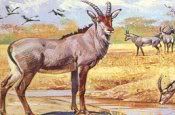 another pic from my computer |
|
|
|
Post by sebbe67 on Oct 28, 2006 11:34:45 GMT
The Bluebuck or Blue Antelope (Hippotragus leucophaeus) is an extinct species of antelope, the first large African mammal to disappear in historic times. It is related to the Roan Antelope and Sable Antelope, but slightly smaller than either. It lived in the southwestern coastal region of South Africa, but was more widespread during the last Ice Age. It was probably a selective feeder, preferring high-quality grasses.
Europeans encountered the Bluebuck in the 17th century, but it was already uncommon by then. It may have been affected by competition from domestic sheep, which reached South Africa around AD 400, after being traded with tribes from the north. European settlers hunted it avidly, despite its flesh being distasteful, while converting its habitat to agriculture. The Bluebuck became extinct around 1800. There are only four mounted specimens – in museums in Vienna, Stockholm, Paris, and Leiden – along with some bones and horns elsewhere. None of the museum specimens show a blue colour, which may have derived from a mixture of black and yellow hairs.
|
|
|
|
Post by another specialist on Oct 28, 2006 21:25:24 GMT
ANTELOPE horns" BLUE ANTELOPE horns Hipportragus leucophaeus Museum specimen, South Africa Hunted to extinction in the early 1800's  Photographer: MARTIN HARVEY |
|
|
|
Post by Carlos on Aug 10, 2007 17:08:39 GMT
Afterlife: the mounted skin at Naturalis, Leiden (The Netherlands) The Blue Antelope in Leiden is the scientific "type" specimen, that was described by the naturalist Pallas in 1766. It is a remarkable specimen, not just because of its value as exemplar of an extinct species. The quality of its taxidermy is excellent - having been done by the famously skilled Dr. Klockner. As such it stands as a significant object in cultural as well as zoological history. 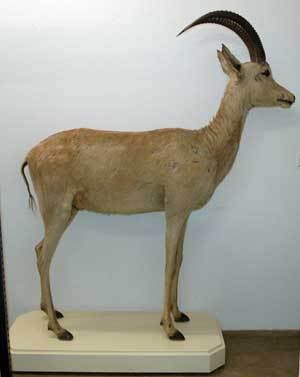 www.blueantelope.info/files/Mleidenbuck1.jpg www.blueantelope.info/files/Mleidenbuck1.jpg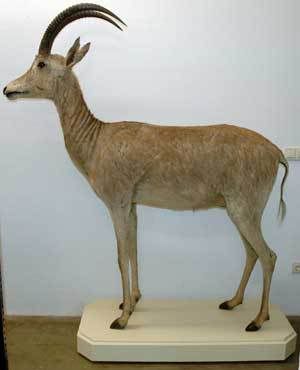 www.blueantelope.info/files/Mleidenbuck2.jpg www.blueantelope.info/files/Mleidenbuck2.jpgImage © RMNH Naturalis Naturalis is the Royal Museum of Natural History in the Netherlands, and this is one of their treasured specimens. Formerly it was on view to the public in a 'Schat Kamer' - translating as treasure room. In the new and purpose built museum it is secure in a tower of twenty storeys dedicated to the taxidermy collection. Further information about Naturalis: www.naturalis.nlThe object history of this specimen has received careful attention. Husson and Holthuis, senior staff at Naturalis, managed to rebuff Erna Mohr's claim (1967)that theirs was not the "type" specimen. Sleuthing skills of the authors and their colleagues meant that a crucial link in the historical chain was found, in the form of a reciept for the transport of the animal from a collection in Haarlem to that in Leiden, in 1842: "For transportation: for the tow-barge f.2.00, for the Antelopes f.0.60. For delivery f. 0.85. For consumptions f. 0.75. For the purchase of the antelopes f. 47.10. Total f. 51.30." (Receipt for passge from Haarlem to Leiden, 1842) The specimen survived the attempts of Jentink, a curator in the end of the nineteenth century, to remove the skull. A few fragments from the lower skull were extracted, but according to Husson and Holthuis, "at least part of the dorsal portion of the skull is still inside the head of the mounted specimen". The skull fragments extracted are shown below: 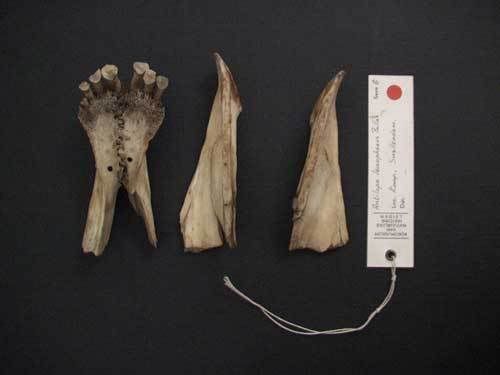 www.blueantelope.info/files/Bleidenskullbits.jpg www.blueantelope.info/files/Bleidenskullbits.jpgImage © RMNH Naturalis www.blueantelope.info/?q=node/16 |
|
|
|
Post by Carlos on Aug 10, 2007 17:13:42 GMT
Afterlife: the mounted skin in Vienna, Austria  www.blueantelope.info/files/Mviennaside2.jpg www.blueantelope.info/files/Mviennaside2.jpg www.blueantelope.info/files/Mviennaside3.jpg www.blueantelope.info/files/Mviennaside3.jpgImage © Natural History Museum, Vienna The Natural History Museum in Vienna has one of the four surviving blue antelope skins, mounted as a specimen. This specimen came into the collections some time between 1786 and 1800, and is the only female in existence. The following is a translation of the report by Erna Mohr, in her monograph of 1967. The mounted Blaubock of the Vienna Museums is a female. It is not known how they got it. KOHL in 1886 wrote about it with no hint of where it came from. He was however convinced about leucopaheus as an independent species. He juxtaposed measurements of the bluebuck on show with the measurements of a female roan antelope in the Vienna collection. (The first measurement given is H.leucophaeus, the second, H. equinus) Length of body without tail.................i) 188 ii) 200 Length of tail without brush................i) 49 ii) 61 Shoulder height..................................i) 102 ii) 124 Horn, start of proximal curve..............i) 51 ii) 38 Linear distance from back horn...........i) 41 ii) 33 Circumference of horn tip at its base...i) 12.5 ii) 13.5 Length of horn without annulations....i) 13.7 ii) 16 Number of annulations.......................i) 26 ii) 13 As in 1967, the mounted animal in Vienna appears to be the best. It is a bit higher at the withers than at the 'Kruppe'. It has quite visible hair whirls. SCHREBER in his description of the species has very carefully referenced these. Hair whirls on the lower neck are very clear to see, very prominent. 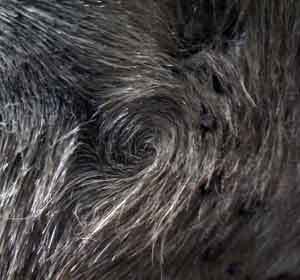 www.blueantelope.info/files/Mviennaswirl.jpg www.blueantelope.info/files/Mviennaswirl.jpgThe parting in the hair is near the top of the nose. The bright spot over the eye appears quite clearly as Pallas (1766) desribed the object. In contradiction to later authors, such as BUFFON (1778 etc.) and SHAW (1801) who accept a white line, as opposed to a spot, from the eye to the rhinarium, as in niger, the sable antelope. A dark patch specified within the light circle over the eye is visble [..?]. The tail tip is very nice and more full in comparison to the other three examples, which have shrunk considerably over the last couple of hundred years. The back is lighter than the other three males, and it is not known if this is a gender difference or it is bleached. 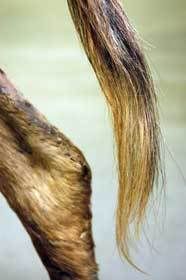 www.blueantelope.info/files/Mviennatail2.jpg www.blueantelope.info/files/Mviennatail2.jpgTranslated from German to English with the kind help of Doris Voetter. Grateful thanks to the staff of the Mammal Section at The Natural History Museum in Vienna for help and permission to use photographs of the mount here and elsewhere in this website. Images © Natural History Museum, Vienna www.blueantelope.info/?q=node/17 |
|
|
|
Post by Carlos on Aug 10, 2007 17:15:44 GMT
|
|
|
|
Post by another specialist on Aug 10, 2007 21:28:19 GMT
|
|
|
|
Post by another specialist on Aug 10, 2007 21:39:44 GMT
Afterlife: The "Glasgow" skull In 1949, a 'new' skull appeared in the literature. Robert Broom published a letter in the scientific journal, Nature, announcing the presence of a blue buck skull in the Hunterian Museum. An eminent scientist, born in Scotland but living in South Africa, Broom was confident "that this Hunterian specimen is a good skull of the extinct blue buck." skull   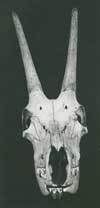  Erna Mohr's monograph (1967) sceptically reviewed blaubok specimens. She conducted a correspondence with Miss E Macartney, Museum Assistant in the Hunterian Zoology Museum at the at time. envelope back & front 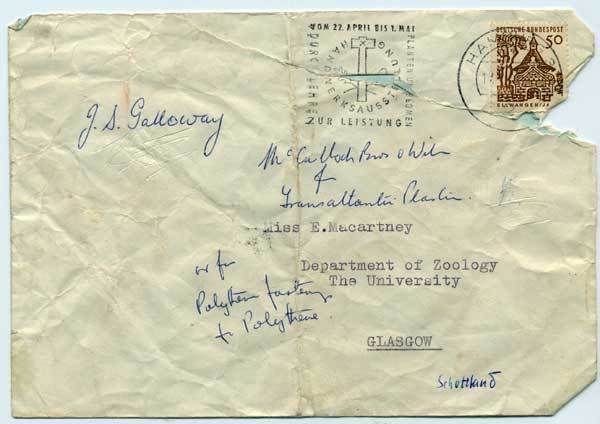 www.blueantelope.info/files/Hunterscans/envfrontB.jpg www.blueantelope.info/files/Hunterscans/envfrontB.jpg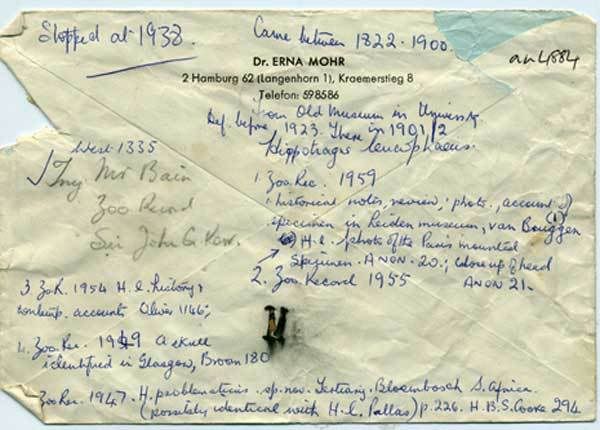 www.blueantelope.info/files/Hunterscans/envbackBB.jpg www.blueantelope.info/files/Hunterscans/envbackBB.jpgDoubt was cast on Broom's assignation by Klein (1974), an American archaeologist working with the South African Museums. His paper reiewed the implications of osteological remains found in South Africa. With respect to the "Glasgow" skull, Klein noted that it was difficult to compare it on the basis of its teeth, as 'intact molar and premolar rows are poorly represented in fossil samples' (1974:110). He deduced, correctly, that Erna Mohr's monograph contained a misprint with respect of the length of the upper premolar row - it should have read 45mm, not 35 mm.  Molars In 1995, Groves and Westwood responded to Klein's work with some new research: "We are convinced they [the skulls in Glasgow and Amsterdam] are genuine skulls of the extinct blaauwbok." (Groves and Westwood, 1995:317) 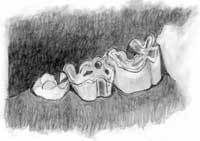 Molars Erna Mohr's monograph represents the most complete study of the Blue Antelope to date. Click on the pdf logo below for her text about the 'Glasgow' skull: |
|
|
|
Post by another specialist on Aug 10, 2007 21:44:22 GMT
Robert Broom and the "Glasgow" skull Robert Broom in later life "Having only one skull, one cannot tell how the species may vary; but in this skull there are a number of important characters which distinguish it from the skull of the living roan antelope (Hippotragus equinus) and the sable antelope (Hippotragus niger). The length of the base of the skull is 14 1/4 in. (360mm). I have seen one specimen of a sable as small, but none of the roan. As will be seen from the photograph, a striking feature not seen in the roan or sable is the depression of the snout below the general line of the maxillary teeth, and with it the bending down of the front of the lower jaw. The premaxilla is more slender than in the other species, and the angle made by the nasal with the front of the supra-orbital part of the frontal is less obtuse. The horn cores are slender and less curved than in most of roan or sable. There are one or two important dental characters which seem to confirm this being the extinct Hippotragus leucophaeus. These, and other features of the skull, will be described in a full account of it which will be published elsewhere." (Broom, 1949) www.blueantelope.info/?q=node/36 |
|
|
|
Post by another specialist on Aug 10, 2007 21:45:32 GMT
The "Glasgow" skull's object history Erna Mohr quoted Miss Macartney, from their correspondence about the skull: 'History in Zoological Museum: Very unsatisfactory. No mention of this specimen in any of our catalogues. These are incomplete and do not go back beyond 1807. There is a massive gap from 1820 to 1904. There does not exist a complete list of the original Hunterian zoological specimens. I have learned from a former devoted worker in the museum that the skull was in the old zoological museum in Glasgow University before our department was built in 1923 and came from us thence. It was thus definitely acquired before 1923, and in addition he is quite certain it was already in the posession of the university in 1901 or 1902.' (Mohr, 1967:48) www.blueantelope.info/?q=node/37 |
|